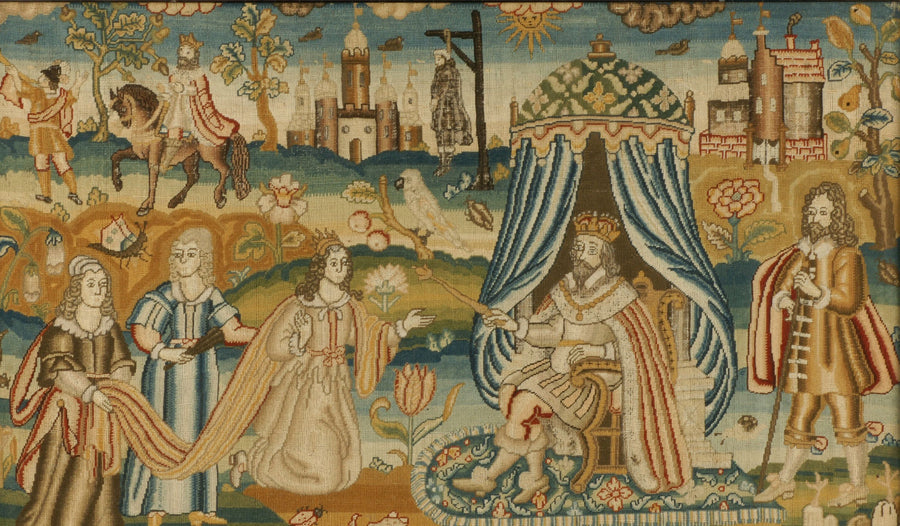
SEWN UP: THE FELLER COLLECTION
 Image: Esther and Ahasuerus, Mid to late 17tth century, 29.7 x 43.7cm. Feller Collection
Image: Esther and Ahasuerus, Mid to late 17tth century, 29.7 x 43.7cm. Feller Collection
Micheál and Elizabeth Feller have created one of the finest collections in England rivalling the Goodhart Collection at Montacute House in Somerset. The Feller Collection comprises over three hundred samplers and items of needlework, ranging from mid-17th-century band samplers—including a rare Judith Hayle Ipswich School sampler dated 1696—to Charles II stumpwork pictures, Ackworth Quaker School samplers and beautiful Regency examples.
From Tuesday 9 November there will be a sale featuring items and contents of the Feller's home, Upper Slaughter Manor, including many fine examples of samplers and needlework, as well as oak and walnut furniture, Delft pottery, treen, paintings and metalware.
Read on for the article that featured in Issue 62 Thread about the extensive collection of 17th century embroideries that the Fellers donated to the Ashmolean Museum: Sewn Up, Embroideries from the Ashmolean's Feller Collection.

Image: A needlework sampler by Mary Ann Godsall, 19th century.
Just occasionally, a woman’s voice can be heard across the centuries, sharp as the needle held in her reluctant hand. Lucy Hutchinson recalled her childhood detestation of needlework in no uncertain manner: ‘and for my needle, I absolutely hated it.’ But the needle could also offer solace.
Emanuel Ford’s 1607 novel The Most Pleasant History of Ornatus and Artesia provides a rare glimpse of a woman turning to her embroidery at a time of stress. The lovers Ornatus and Artesia suffer tortuous twists of fate, shipwreck and cross-dressing before achieving a happy ending. Long before this, Ford describes Artesia ‘alone in her bed’, her sleep disturbed by dreams. Seeking to calm herself, he describes her ‘opening her casket to take out her sampler, wherein she took most delight.’ Whether at school or at home, affluent 17th century schoolgirls and young women clearly spent many hours focused on their embroidery. Using shockingly vivid silks and shining golden and silver threads, sequins, glass beads, pearls, coral and mica, these embroiderers created miniature worlds depicting Biblical and classical stories, in detailed landscapes filled with imaginary and real creatures, along with flowers or worked floral and geometric designs.

Image: A George III needlework sampler by Hannah Backhouse
While the extraordinary textual qualities of the raised work and the intricacy of the samplers enchant us today, it was the act of making that was important at the time. The concentration required by stitching demonstrated discipline, both social and spiritual. The ability to buy the luxurious threads and spend time on fancy embroidery rather than functional needlework indicated status, wealth and good breeding. Learning such ‘curious work’ was a key feature of the girls’ boarding schools which flourished during the 17th century. In 1628, the Court of Aldermen sent the orphan ward Anne Heather to Mrs Friend’s school in Stepney so she could benefit from ‘learning at her needle, writing, musick and other qualities’...
Extract from the article Sewn Up: Embroideries from the Ashmolean's Feller Collection in Issue 62 Thread. Read the rest of the article here.
Find out more about the Feller Collection Upper Slaughter Manor sale here: www.wooleyandwallis.co.uk
